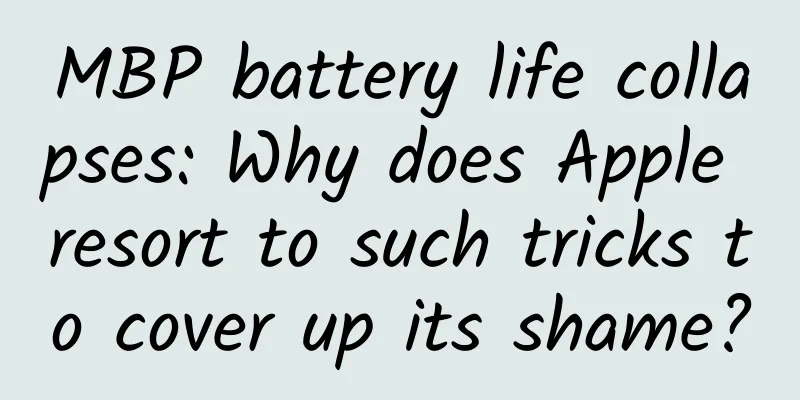MBP battery life collapses: Why does Apple resort to such tricks to cover up its shame?

|
Every system update is exciting, after all, everyone likes to see new changes in new versions. However, the latest macOS 10.12.2 has an update that has caused controversy, that is, the remaining battery time display has been cancelled. In the face of user complaints about battery life, Apple's solution always feels strange. So, what is the actual situation? Battery life is a big problem When Apple released the 2016 MacBook Pro in October this year, it clearly stated that the new machine's battery life can reach 10 hours. However, after the device was released, people complained - they found that the promised 10 hours seemed to be unattainable. Considering that many manufacturers' advertised battery life is not based on real daily use cases, it is not surprising that the actual battery life of the new MacBook Pro is below the standard. However, due to the psychological gap, people still complained one after another. One user said in Apple's official community: "I got the 15-inch MBP a few days ago, but I was very disappointed with its battery life. If I just use Safari at 50% brightness to do some light web browsing, I can use it for about 6 hours, but this is a big gap from the promised 10 hours." There are more and more related complaints, and Apple can't turn a deaf ear to it. Sources said that before the push of the new version of macOS began, Apple had already launched an internal investigation and ruled out the possibility of hardware defects. Next, in the new version of macOS 10.12.2, which has already arrived, Apple's solution surprised many users: removing the remaining battery time display at the top. That is to say , if you click the battery icon in the upper right corner, you will no longer see the remaining time display of "○:○○ left". Apple's move will definitely make many users puzzled - if the battery life problem is not solved, isn't it a standard ostrich mentality to remove the remaining time display? That's right, Apple's style should not use such a rough solution. What is the problem? The problem In fact, Apple officials themselves have also given an answer as to why the remaining battery time display should be cancelled. Apple told The Loop: "The percentage display is accurate, but because of the dynamic algorithm we use on our computers, the remaining time estimate does not accurately track user behavior. Any operation we perform on our MacBook will affect battery life to varying degrees, so if the indicator bar is not accurate, it will cause trouble to users. In addition to the application working, there are many activities running in the background, and users often do not realize that these things will also affect battery life." In other words, the number displayed for the remaining time is based on the current power consumption of your device, so it may be different at any time. Running a big game, you may see that the battery life is only 2 hours; turning off the game and other applications, this data may immediately return to 5 to 6 hours. Judging from the feedback from users in the official Apple community, most people do not actually test and calculate the actual battery life of their MacBook Pro, but only draw conclusions by checking the remaining time. According to Apple, the current display result cannot be used as the actual total battery life of the laptop. The external site 9to5Mac once did a test: after opening the Photoshop software and using it, the remaining time displayed dropped to about 3 hours and 50 minutes. When the application is completely closed, there is no change in the remaining time. However, after actual use, it was found that the MacBook Pro lasted a little more than 6 hours. This example may illustrate that there is a considerable gap between the dynamic calculation of the remaining time and the actual battery life of the device. Why is this so? When the MacBook is actually running, it will switch between low power consumption and high performance modes in real time according to the different task loads currently performed by the device. However, the update of the remaining time status is not completely real-time, but has a certain update frequency. Therefore, the change of this data may not keep up with the changes in the system, and it is not impossible to mislead people. However, there is one thing that people are very concerned about: the calculation mechanism of the remaining power available time of MacBook was not introduced from the 2016 MacBook Pro. It has been with people for a long time. Why did users' dissatisfaction only begin to erupt now? First of all, as mentioned above, the latest processor used in the 2016 MacBook Pro is very efficient in system load identification and state switching, resulting in the "failure" of the remaining battery life status update. This has led to more people misunderstanding it. After all, there are still few users who really use actual measurements to test whether the battery life is really that little. Another pot may have to be taken by macOS Sierra itself. Sources familiar with Apple's decision-making said that the company believes that many of the new system's features that rely on iCloud synchronization are also one of the main reasons why users will pay special attention to the battery life of the new machine. Since macOS Sierra, Apple's computer system has begun to be networked and service-oriented on a large scale, and iCloud is the main force leading this change. In order to bring users a more automated experience, many of macOS's features now need to rely on iCloud to be implemented. Whether it is optimizing storage or organizing the Spotlight directory, as well as the photo facial recognition organization and archiving that Apple has been vigorously promoting, these have to be done silently in the background. If there is a large amount of data in iCloud itself, then the synchronization work will be even more arduous. macOS now relies so much on cloud functions and artificial intelligence technology. Although these services are not eye-catching, they do affect the battery life quietly. We cannot arbitrarily say that the battery life officially promoted by MacBook Pro is false, but since the adoption of macOS Sierra, the factors affecting the energy consumption of Mac are much more complicated than in the past. This is beyond doubt. Do you care? It cannot be denied that it has become a habit for many Apple fans to check the remaining battery life from time to time to judge how long their MacBook can be used. This can indeed give people an intuitive impression. However, it has become increasingly inaccurate, and Apple has decided to remove this feature. It seems that we can only adapt to it in the future. In fact, many netizens now say that just looking at the battery percentage is intuitive enough. This is just like the iOS system. We don’t need to see how many hours the battery will run out, but we still use it the same way. Apple’s "up to 10 hours" is of course only achievable under specific conditions and specific settings. Even if we use it lightly in daily life, the condition of the computer may be much more complicated than Apple’s test environment. Therefore, there is no need to worry too much about it. The laptop market is like this. Compared with the current situation, we certainly still hope that Apple can shake its body and come up with a solution that has the best of both worlds. But Apple is not omnipotent after all, and they can only use the simplest way to solve this problem. If you can’t check the remaining battery life in the future, will you care?As a winner of Toutiao's Qingyun Plan and Baijiahao's Bai+ Plan, the 2019 Baidu Digital Author of the Year, the Baijiahao's Most Popular Author in the Technology Field, the 2019 Sogou Technology and Culture Author, and the 2021 Baijiahao Quarterly Influential Creator, he has won many awards, including the 2013 Sohu Best Industry Media Person, the 2015 China New Media Entrepreneurship Competition Beijing Third Place, the 2015 Guangmang Experience Award, the 2015 China New Media Entrepreneurship Competition Finals Third Place, and the 2018 Baidu Dynamic Annual Powerful Celebrity. |
>>: Qualcomm has bullied Intel with Win 10, so Intel really doesn't plan to fight back?
Recommend
About Baidu promotion, what is Baidu search promotion?
Baidu search promotion is a pay-per-performance o...
Crazy Xiao Yangge: E-commerce will not cause the real economy to fall, it will only make goods cheaper
Recently, some people believe that the developmen...
Huadu WeChat ordering mini program development, how much does it cost to develop a food ordering mini program?
Nowadays, many offline businesses are trying out ...
Put down the remote control and go to the cinema. This is the truth behind the rise of cinema chains.
When the Internet connects living rooms, every fa...
Advanced live broadcast room operation, save it now!
1. Live broadcast content planning Some students ...
Why are space stations and satellites of various countries all concentrated in orbits at an altitude of 400 kilometers?
Not long ago, I was asked a very interesting ques...
Information flow delivery trends of Bytedance, Baidu, and Guangdiantong in 2022!
Today, let’s take a look at the three major infor...
Liyang SEO Training: What methods are needed to achieve a high ranking in website promotion and marketing?
When we usually use a search engine, we will ente...
iOS 12 verification code autofill is convenient, but is it secure?
One of the new features of iOS 12, which will be ...
How to plan an excellent event? Follow these 5 steps
Whether you are doing user operations, new media ...
The Civic TYPE R special edition concept car may enter the Chinese market in the future
During the 2018 Tokyo Tuning Show, Honda official...
How to promote offline activities?
In a year, it is always necessary to plan and exe...
Rub and rub! Apple Watch screen scratch resistance test is terrible
Earlier this month, foreign users used electric d...
User operation: user growth in the post-traffic era!
The decline of traffic dividends is now an irreve...
Misunderstood "emotional intelligence": judging emotions through micro-expressions is indeed a science
Leviathan Press: "A wise man is honest and r...









